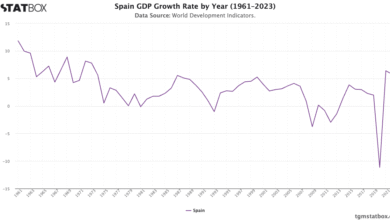Private Sector Hiring: Slowest Increase in Two Years

Private sector hiring saw a notable slowdown in May, with only 37,000 jobs added, according to the latest ADP employment report. This figure represents the weakest growth in over two years, significantly falling short of the anticipated 110,000 jobs and down from the previous month’s addition of 60,000. As employment rates become a focal point amid fluctuating economic conditions, these numbers highlight the shifting landscape of the job market. With job market trends showing inconsistent growth, experts are cautiously evaluating the implications for future May job growth and beyond. This report arrives as businesses and policymakers alike analyze the overall health of the employment sector.
In May, the landscape of employment within the workforce took a step back, as private business recruitment revealed only a modest increase of 37,000 positions, according to ADP’s assessment. This slow pace of job creation starkly contrasts with previous months and raises concerns about ongoing hiring patterns. The job recruitment scene, often influenced by broader economic dynamics, is witnessing fluctuations that could signal a larger trend in labor demand and supply. Various segments of the economy are experiencing differing levels of activity, and this divergence could shape how companies strategize their staffing endeavors moving forward. Observers are keenly watching these developments to gauge the potential impact on future employment opportunities.
Private Sector Hiring Challenges
Private sector hiring in May hit a significant downturn, with only 37,000 jobs added according to the latest ADP employment report. This figure represents the lowest growth in private payrolls in over two years, falling short of both the previous month’s performance and expert forecasts. Analysts expected at least 110,000 new jobs; however, the actual number marked a drastic reduction from the 60,000 jobs added in April. Such a decline highlights serious challenges in the current job market, which is grappling with weaker demand and hiring practices.
This decline in job creation is part of a larger trend affecting various sectors of the economy, particularly impacting small businesses. Companies with fewer than 50 employees lost 13,000 jobs, underscoring the struggles smaller firms face amidst tightening economic conditions. Coupling the weak hiring numbers with projected increases in unemployment rates, the bleak outlook has raised alarms among economists about the sustainability of the current employment landscape.
May Job Growth and Economic Conditions
Despite the slower pace of job growth observed in May, the ADP report suggests notable variations across different sectors. The goods-producing sectors actually experienced job losses, whereas some service industries like leisure and hospitality continued to display resilience. The overall economic conditions impacting job growth reflect a volatile marketplace where optimism is met with caution. While annual pay increases remain robust, with a 4.5% rise for those in stable positions and a notable 7% for job switchers, the underlying uncertainty raises questions about future job growth.
As the Bureau of Labor Statistics prepares to release its nonfarm payroll report, the economy’s prevailing conditions will undoubtedly influence hiring trends moving forward. While the ADP report points to a slowdown in employment growth, experts are divided on the implications for broader job market trends. Some believe that we may be witnessing a recalibration period in response to fluctuating demand and rising inflation due to external factors, like tariffs. Consequently, how businesses respond to these economic challenges will be crucial in shaping future employment rates.
Job Market Trends and Wage Growth
Job market trends in May reveal a complex situation where despite a slowdown in hiring, wage growth remains robust. The latest data indicate a 4.5% annual pay increase for employees staying in their roles, while those changing jobs see an impressive 7% hike. This wage growth signals a persistent demand for talent, particularly in sectors where companies must compete vigorously to retain skilled workers. The apparent contradiction between slowed hiring and healthy wage growth underscores the complexities of the current labor landscape.
However, not all sectors benefit equally from these trends. The leisure and hospitality sectors continue to show promise with job gains; yet industries like professional services have faced setbacks leading to downward pressure on overall job numbers. As businesses adjust to these layering economic factors, future job market trends will likely hinge on both hiring capacities and wage inflation. Employers will need to navigate these dynamics to retain talent while ensuring sustainable growth amidst mixed employment reports.
Analyzing Economic Conditions Impacting Employment
Economic conditions play a pivotal role in influencing employment trends, as indicated by the mixed signals from recent labor market reports. The Federal Reserve’s outlook remains cautiously optimistic, although concerns regarding tariffs and their potential impact on prices and jobs persist. As Fed Governor Lisa Cook pointed out, while the U.S. economy is still strong, the increased uncertainty affects both unemployment and overall economic stability. These insights highlight the delicate balance policymakers must maintain while encouraging growth.
Factors such as inflation, hiring intentions, and job openings remain critical variables in deciphering the health of the job market. Rising job openings, reported by the BLS, contrasted sharply with some surveys that suggested a cooling in hiring intentions. This inconsistency showcases the volatile nature of economic conditions and the unpredictability of employment rates. Knowing that decisions made by the Federal Reserve in the upcoming meetings could further affect these trends adds another layer of complexity to the employment landscape.
Sector-Specific Employment Insights
The ADP employment report demonstrates that sector-specific dynamics significantly influence private sector hiring trends. While the construction sector recorded a job gain of 6,000, other industries like natural resources and manufacturing saw declines. This divergence highlights how economic conditions impact sectors differently, with some flourishing amid challenges while others contract. The resilience seen in leisure and hospitality, which added 38,000 jobs, illustrates the continued consumer demand for these services despite economic fluctuations.
Furthermore, the report signals troubling shifts within professional and business services, which faced a loss of 17,000 jobs. Such declines could be symptomatic of broader economic slowdowns, indicating that specific sectors may struggle more as economic conditions change. Companies must remain adaptable and responsive to these sector-specific trends to maintain a robust workforce while navigating the complexities of hiring in a rapidly evolving job market.
The Implications of Job Numbers on Economic Policies
Job numbers significantly inform economic policies, providing crucial insights into the health of the labor market. Policymakers and economists closely observe these figures to gauge inflationary pressures and employment levels within the economy. A strong labor market typically allows for a proactive approach toward monetary policy; however, with the recent ADP report signaling job growth weaknesses, cautious measures may take precedence. The Federal Reserve’s decisions on interest rates will depend heavily on the nuances of employment and future economic predictions.
This approach highlights a critical aspect: employment numbers do not exist in isolation; they influence fiscal and monetary policies alike. As seen from this month’s report, the repercussions of lower job growth echo through other economic indicators, affecting everything from consumer spending to business investment decisions. Policymakers must remain agile in their strategies, adapting to labor market fluctuations to foster sustained economic growth and stability.
The Mixed Signal of Job Openings and Employment Rates
The juxtaposition of rising job openings against sluggish employment rates illustrates the complexities inherent in today’s labor market. Despite ADP’s low job creation figures for May, the simultaneous rise in job openings signifies an ongoing demand for labor. This reflects a paradox where employers are eager to hire but may be constrained by factors such as skill mismatches or economic uncertainty. The clear disparity between the desire to fill positions and the reality of employment rates brings to light challenges that require strategic interventions.
Understanding these dynamics is essential for both job seekers and employers. While rising job openings might suggest opportunities are available, the reality of limited hiring can pose significant barriers. This mixed signal could also lead to further employment tensions in the market, exacerbating the already complex relationship between economic conditions and hiring forecasts. Therefore, navigating this job landscape requires flexibility and adaptability from stakeholders on both sides.
Economic Trends Impacting Employment Decisions
Economic trends exert substantial influence over employment decisions made by businesses and job seekers alike. The current climate, marked by rising costs and inflation, directly impacts how companies approach hiring. With ADP reporting dwindling job growth, businesses may become more hesitant to expand their workforce in the face of uncertain economic conditions. This cautious approach can further contribute to a stagnant job market, emphasizing the necessity for strategic planning by organizations aimed at sustainable growth.
For job seekers, understanding these economic trends is equally crucial. With shifting employment rates, candidates may need to prepare for a competitive job market where demand fluctuates based on broader economic indicators. As businesses reassess their hiring strategies, job seekers should focus on acquiring skills that align with industries currently expanding, such as construction and leisure services. This proactive approach will enable them to navigate the complexities of the evolving job market effectively.
The Future of Employment Under Current Economic Policies
The future of employment hinges significantly on the effectiveness of current economic policies and how they adapt to changing market conditions. As evidenced by the meager increase of 37,000 jobs reported for May, it’s crucial for policymakers to reconsider their strategies to stimulate job growth and bolster the economy. The challenges posed by tariffs and inflation as perceived risks indicate that employment trends may face additional pressures if these issues remain unresolved.
Furthermore, as the Federal Reserve prepares to make decisions regarding interest rates, the trajectory of job growth will play a pivotal role in guiding these policies. A focus on strengthening sectors resistant to downturns, such as education and services, could help mitigate potential job losses across the economy. In light of these considerations, businesses and government officials must collaborate closely to foster a climate that nurtures sustainable employment growth.
Frequently Asked Questions
What does the ADP employment report indicate about private sector hiring trends?
The ADP employment report shows that private sector hiring rose by only 37,000 jobs in May, marking a significant decline from the 60,000 jobs added in April. This decrease is the lowest increase in private sector hiring seen in over two years, highlighting current job market trends that suggest economic conditions may be putting a strain on employment rates.
How does May job growth compare to previous months in the private sector?
In May, job growth in the private sector reflected a mere 37,000 positions, significantly lower than the 60,000 reported in April and far behind the Dow Jones forecast of 110,000. This acceleration in private sector hiring indicates a cooling job market, suggesting that economic conditions are affecting overall employment rates.
What sectors contributed to the recent changes in private sector hiring according to the ADP report?
According to the ADP report, private sector hiring experienced gains in leisure and hospitality (38,000 jobs) and financial activities (20,000 jobs) but faced losses in goods-producing sectors, including a net loss of 2,000 jobs overall. Such fluctuations demonstrate the challenges facing certain industries in the current economic climate.
What implications does the ADP employment report have for the job market and economic conditions?
The recent ADP employment report reveals that private sector hiring is slowing down, which could have implications for job market trends and economic conditions. With only 37,000 jobs added in May, this signifies potential challenges ahead for employment rates and overall economic stability.
How do private payroll figures from the ADP report affect expectations for the Bureau of Labor Statistics reports?
The private payroll figures from the ADP report often differ from those of the Bureau of Labor Statistics (BLS). While the ADP reported only 37,000 job gains for May, the BLS is expected to show a higher increase of 125,000 jobs. These discrepancies can highlight varying insights into private sector hiring and broader economic conditions.
What challenges might private sector hiring face in the current economic environment?
Private sector hiring may face challenges such as reduced job openings and hiring intentions, as indicated by surveys from Indeed and the National Federation of Independent Business. These trends suggest that economic conditions are currently impacting employment rates and job market dynamics.
What does the annual wage growth indicate for employees in the private sector?
The ADP reported that annual pay for employees in the private sector grew at a rate of 4.5% for those staying in the same position and at 7% for those changing jobs. This wage growth reflects a generally robust labor market despite the slower pace of private sector hiring.
How does the current private sector hiring landscape impact small versus large businesses?
The ADP report disclosed that companies with fewer than 50 employees experienced a job loss of 13,000 positions, whilst firms with 500 or more employees reported a drop of 3,000 jobs. In contrast, mid-sized firms added 49,000 jobs, indicating that private sector hiring dynamics differ significantly across business sizes.
What future trends in private sector hiring should we be aware of based on the ADP report?
Given the current trends from the ADP report, future private sector hiring may continue to reflect cautious optimism amid mixed economic conditions. With a significant slowdown noted in May’s job growth, the labor market might experience further fluctuations as employers adjust to uncertain economic conditions and demographic trends.
How can private sector hiring trends inform job seekers and companies looking to hire?
Understanding current private sector hiring trends, as indicated by the ADP report, can help job seekers identify sectors with growth potential while cautioning against those experiencing job losses. For companies, staying aware of these trends aids in strategic workforce planning and can shape hiring practices to adapt to changing economic conditions.
| Key Point | Details |
|---|---|
| Private Sector Hiring Increase | Private sector hiring rose by only 37,000 in May, the lowest increase in over two years. |
| Comparison to Previous Months | This is a decline from the 60,000 jobs added in April and well below the forecast of 110,000 jobs. |
| Sector Performance | Goods-producing sectors lost 2,000 jobs, with manufacturing down 3,000 and natural resources losing 5,000. Construction added 6,000 jobs. |
| Net Job Changes by Company Size | Companies with fewer than 50 employees lost 13,000 jobs, while mid-sized firms added 49,000 jobs. |
| Wage Growth | Annual pay grew at 4.5% for stable employees and 7% for those changing jobs, reflecting robust wage growth. |
| Economic Outlook | Economists express mixed feelings about the labor market; job openings are rising but hiring intentions are low. |
Summary
Private sector hiring has become a critical topic as it experienced a notable slowdown in May, with an increase of only 37,000 jobs. This figure marks the lowest growth rate in over two years, raising concerns among economists about the momentum of job creation. The sector has seen contrasting trends, with some areas experiencing job losses, while others like leisure and hospitality showed resilience. Overall, the mixed signals in the labor market, combined with the uncertainty from economic policies, highlight the complexity of the current employment landscape.



